- Afrikaans
- Albanian
- Amharic
- Arabic
- Armenian
- Azerbaijani
- Basque
- Belarusian
- Bengali
- Bosnian
- Bulgarian
- Catalan
- Cebuano
- Corsican
- Croatian
- Czech
- Danish
- Dutch
- English
- Esperanto
- Estonian
- Finnish
- French
- Frisian
- Galician
- Georgian
- German
- Greek
- Gujarati
- Haitian Creole
- hausa
- hawaiian
- Hebrew
- Hindi
- Miao
- Hungarian
- Icelandic
- igbo
- Indonesian
- irish
- Italian
- Japanese
- Javanese
- Kannada
- kazakh
- Khmer
- Rwandese
- Korean
- Kurdish
- Kyrgyz
- Lao
- Latin
- Latvian
- Lithuanian
- Luxembourgish
- Macedonian
- Malgashi
- Malay
- Malayalam
- Maltese
- Maori
- Marathi
- Mongolian
- Myanmar
- Nepali
- Norwegian
- Norwegian
- Occitan
- Pashto
- Persian
- Polish
- Portuguese
- Punjabi
- Romanian
- Russian
- Samoan
- Scottish Gaelic
- Serbian
- Sesotho
- Shona
- Sindhi
- Sinhala
- Slovak
- Slovenian
- Somali
- Spanish
- Sundanese
- Swahili
- Swedish
- Tagalog
- Tajik
- Tamil
- Tatar
- Telugu
- Thai
- Turkish
- Turkmen
- Ukrainian
- Urdu
- Uighur
- Uzbek
- Vietnamese
- Welsh
- Bantu
- Yiddish
- Yoruba
- Zulu
Understanding Oil Well Tubing and Casing for Efficient Drilling Operations
Well Tubing and Casing Essential Components of Oil and Gas Extraction
The oil and gas industry relies heavily on a complex system of tools and techniques to extract resources efficiently and safely from the earth. Among the most critical components in this process are well tubing and casing, which play pivotal roles in maintaining the integrity of a well while also ensuring optimal production.
What is Well Casing?
Well casing refers to the steel pipe that is run into the drilled hole and cemented into place to form a protective barrier. The primary purpose of casing is to stabilize the wellbore, preventing it from collapsing during extraction. It also protects groundwater from contamination and isolates different pressure zones within the geological formations. Different types of casing—such as surface casing, intermediate casing, and production casing—are installed at varying depths to accommodate a well's specific needs.
Surface casing is typically the first layer installed and provides a barrier between the well and the surface environment. It also ensures the safe drilling of subsequent sections of the well. Intermediate casing follows, installed to protect the well from unstable formations and unwanted fluids. Finally, the production casing is set in the section from which oil or gas is to be extracted, allowing the hydrocarbons to flow into the wellbore.
What is Well Tubing?
While casing serves as the protective layer of a well, well tubing is the smaller pipe inserted into the production casing. Tubing allows for the efficient extraction of oil, gas, and other fluids from the reservoir. Essentially, it acts as a conduit through which hydrocarbons can flow to the surface. Unlike casing, tubing is designed to be easily removed and replaced, allowing for maintenance and adjustments in production techniques.
well tubing and casing

Tubing is typically made from high-strength materials that can withstand harsh conditions, including high pressures and corrosive environments. The diameter and thickness of tubing can vary based on production requirements and the characteristics of the extraction site. It is also equipped with various accessories such as tubing hangers, which support the tubing string, and packers, which seal off certain areas of the well to prevent the movement of fluids.
The Importance of Well Integrity
Both well tubing and casing are integral to maintaining the integrity of a well. They must be constructed from durable materials that can withstand corrosive fluids and high-pressure environments. The failure of either component can lead to catastrophic consequences, including blowouts, leaks, and environmental damage. Therefore, proper selection, installation, and maintenance of both tubing and casing are crucial for safe and efficient operations.
In recent years, advancements in technology have improved the design and functionality of tubing and casing. Techniques such as sour service ratings and corrosion-resistant alloys have been developed to enhance durability and performance. Moreover, ongoing research into materials and engineering methods aims to further improve the safety and efficiency of oil and gas extraction processes.
Conclusion
In summary, well tubing and casing are fundamental elements in the successful extraction of oil and gas. They ensure the structural integrity of wells, protect surrounding environments, and facilitate the efficient flow of hydrocarbons. As the industry continues to evolve, ongoing innovations in materials and technologies will likely enhance the performance and safety of these essential components, helping to meet the growing global demand for energy resources. Understanding the roles and functions of tubing and casing is crucial for anyone involved in the oil and gas sector and emphasizes the significance of maintaining well integrity throughout the extraction process.
-
Tubing Pup Joints: Essential Components for Oil and Gas OperationsNewsJul.10,2025
-
Pup Joints: Essential Components for Reliable Drilling OperationsNewsJul.10,2025
-
Pipe Couplings: Connecting Your World EfficientlyNewsJul.10,2025
-
Mastering Oilfield Operations with Quality Tubing and CasingNewsJul.10,2025
-
High-Quality Casing Couplings for Every NeedNewsJul.10,2025
-
Boost Your Drilling Efficiency with Premium Crossover Tools & Seating NipplesNewsJul.10,2025







